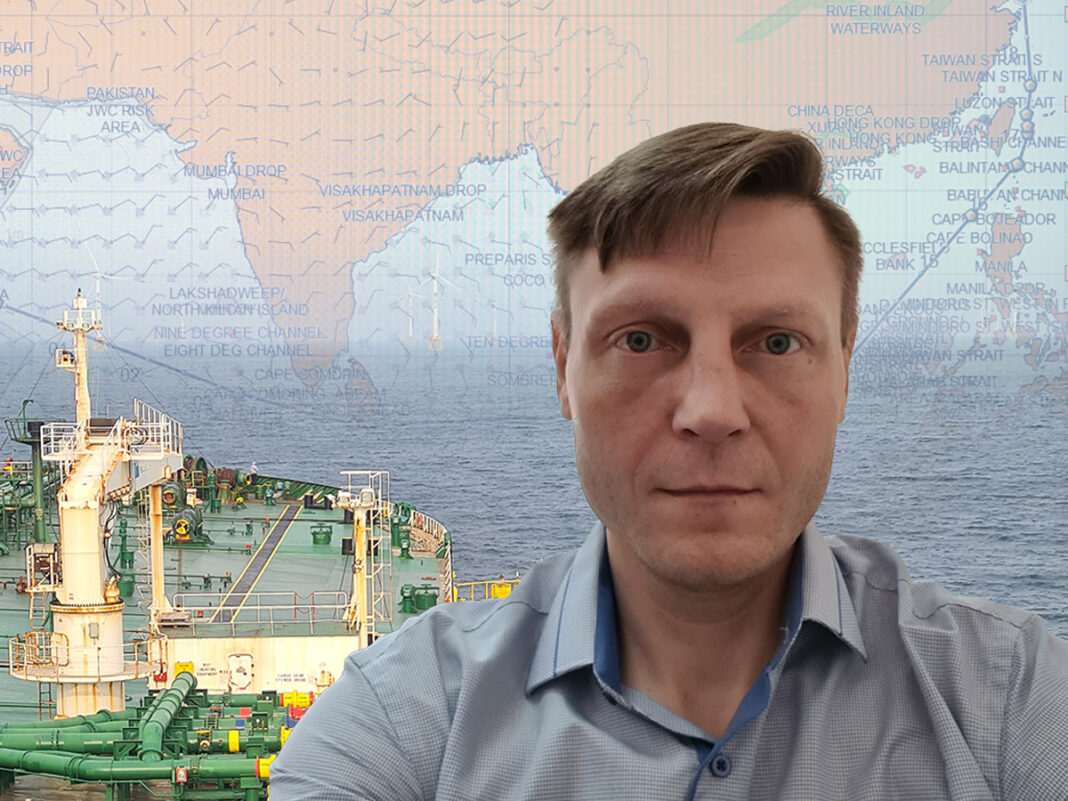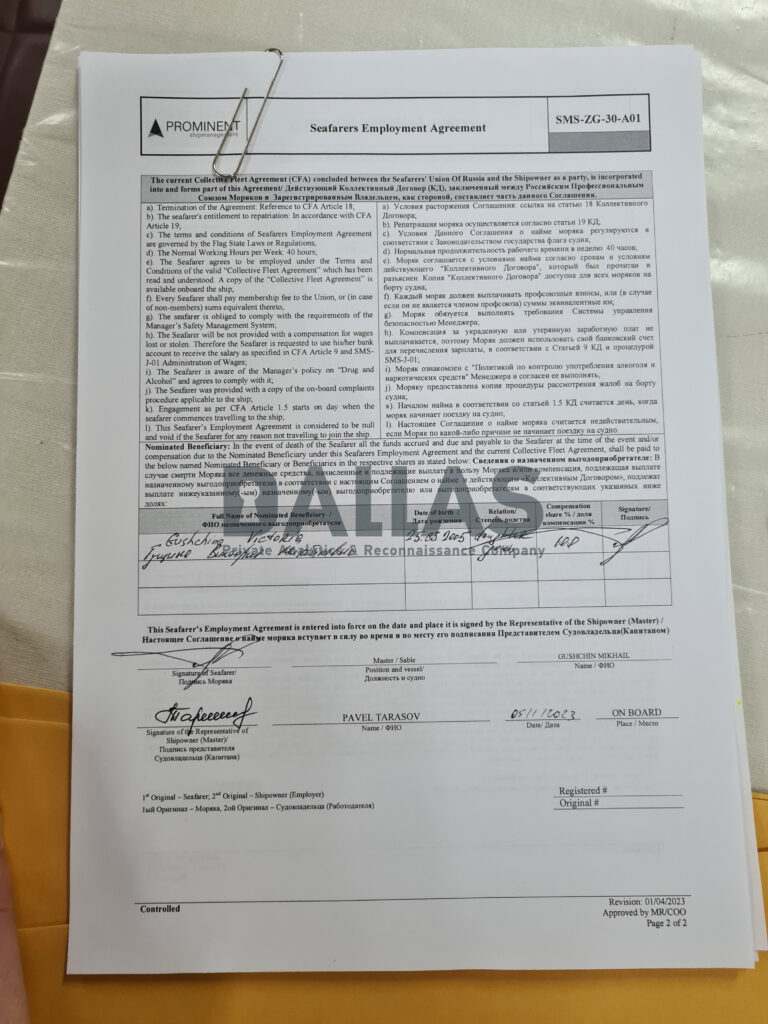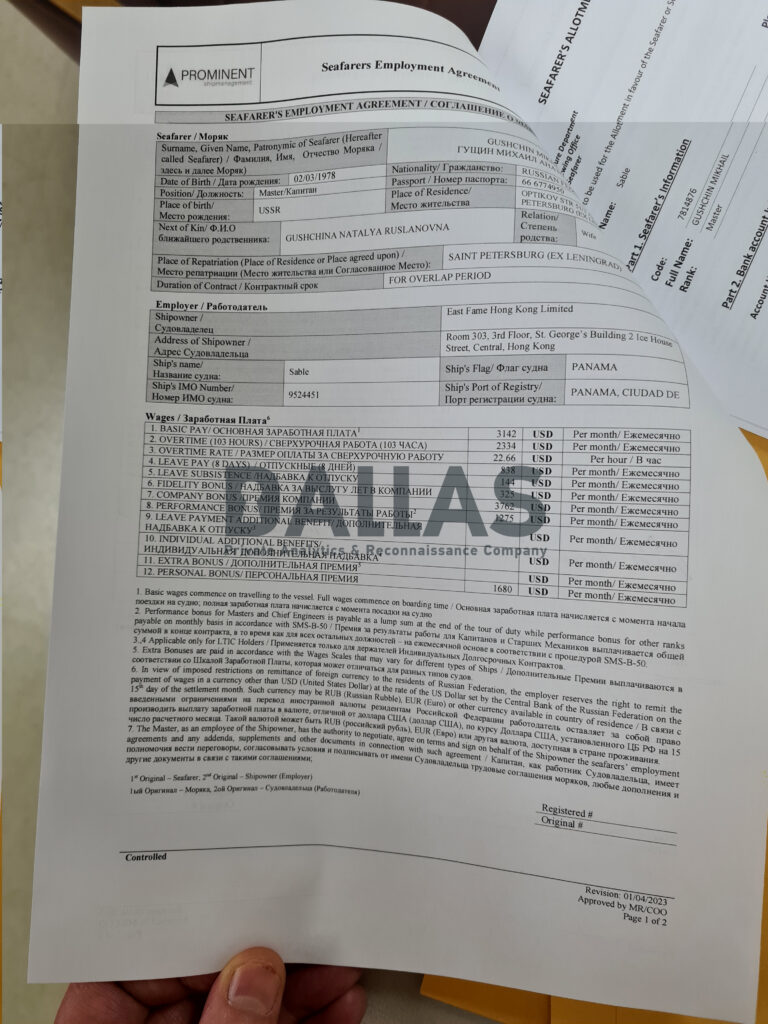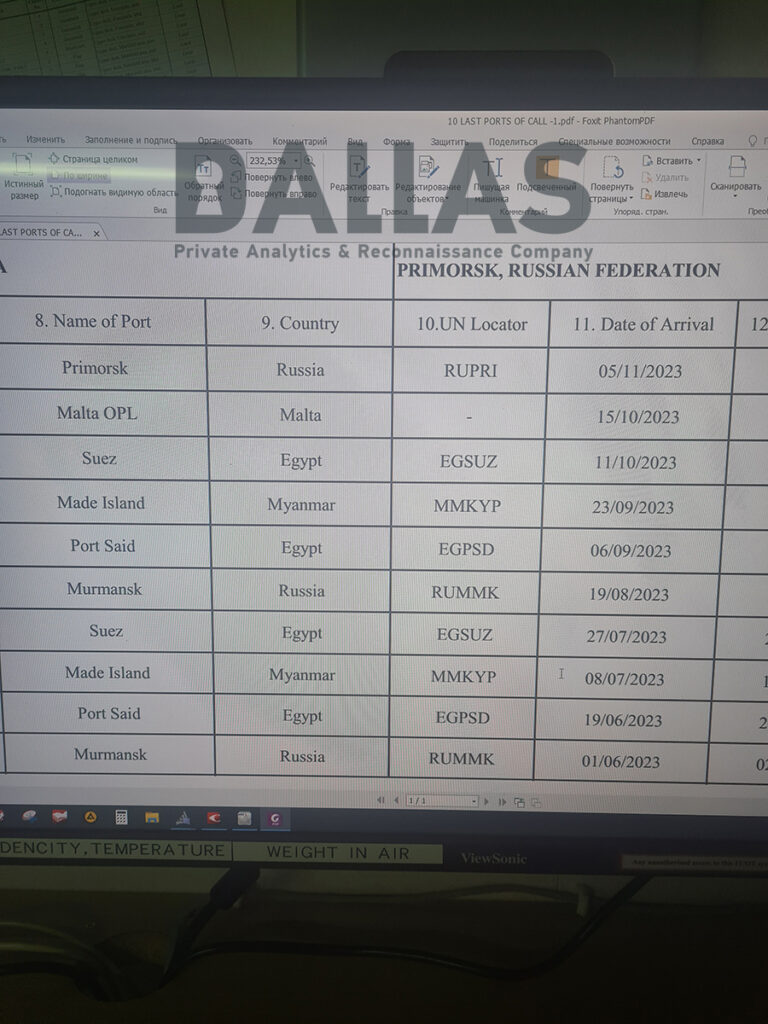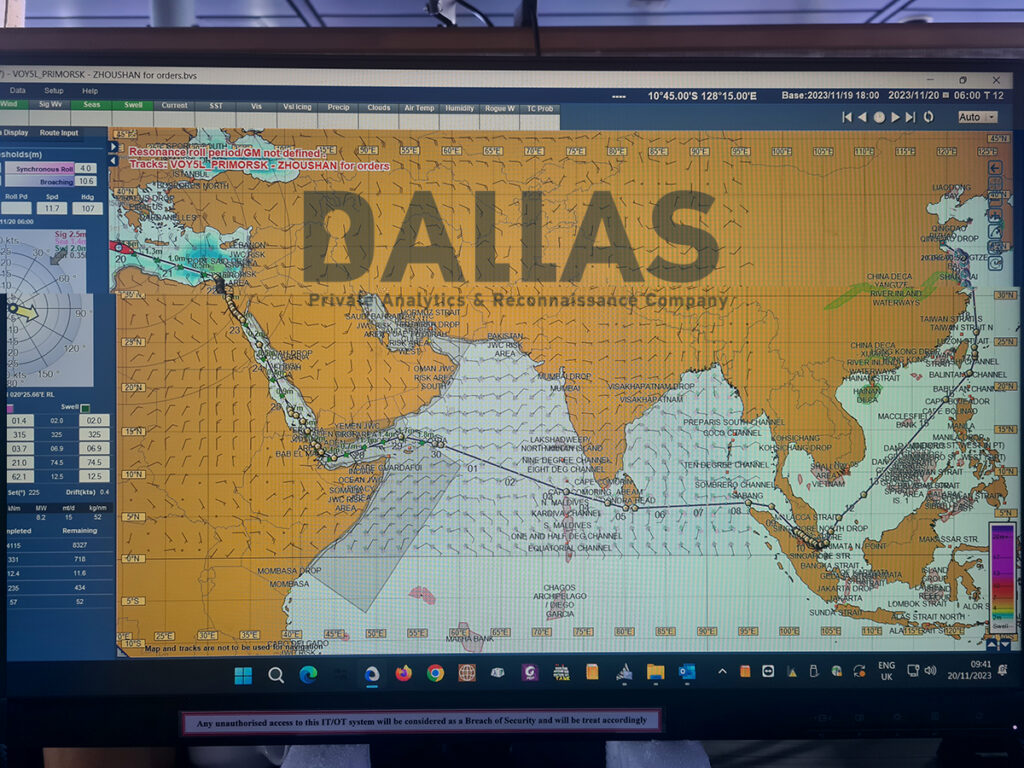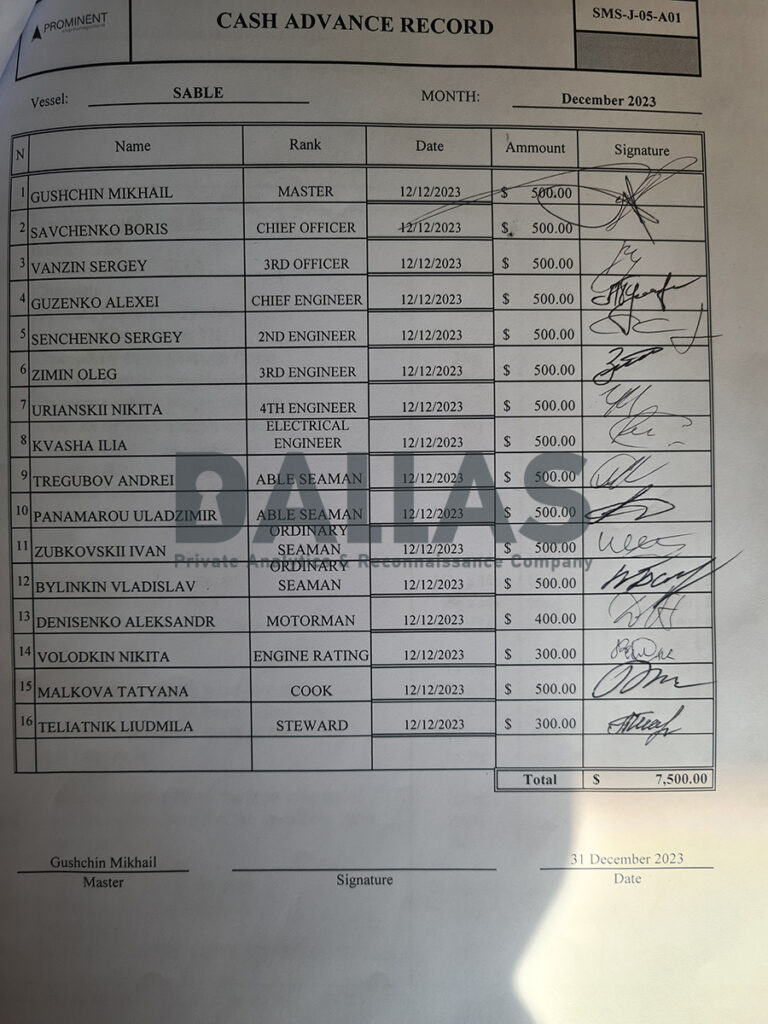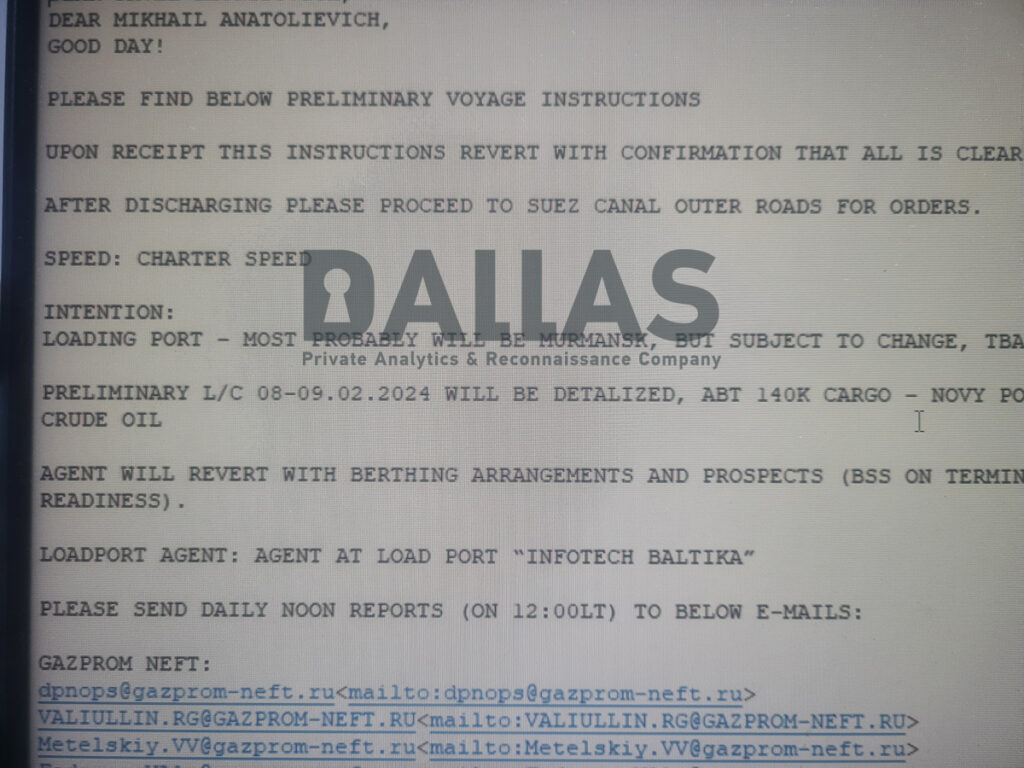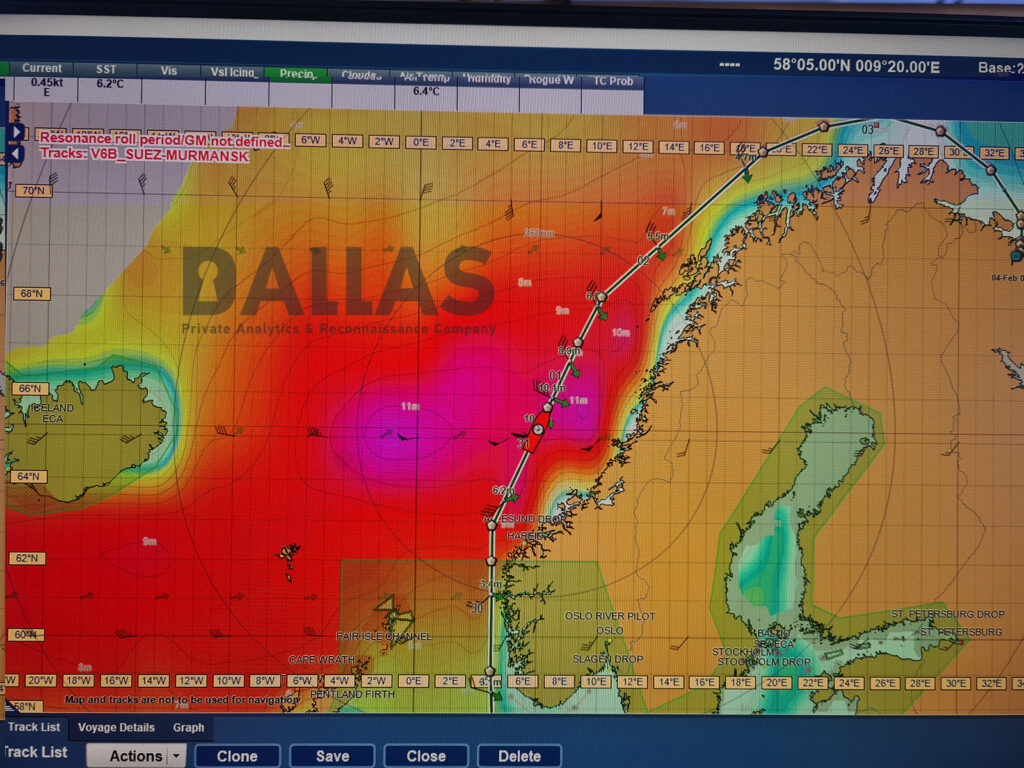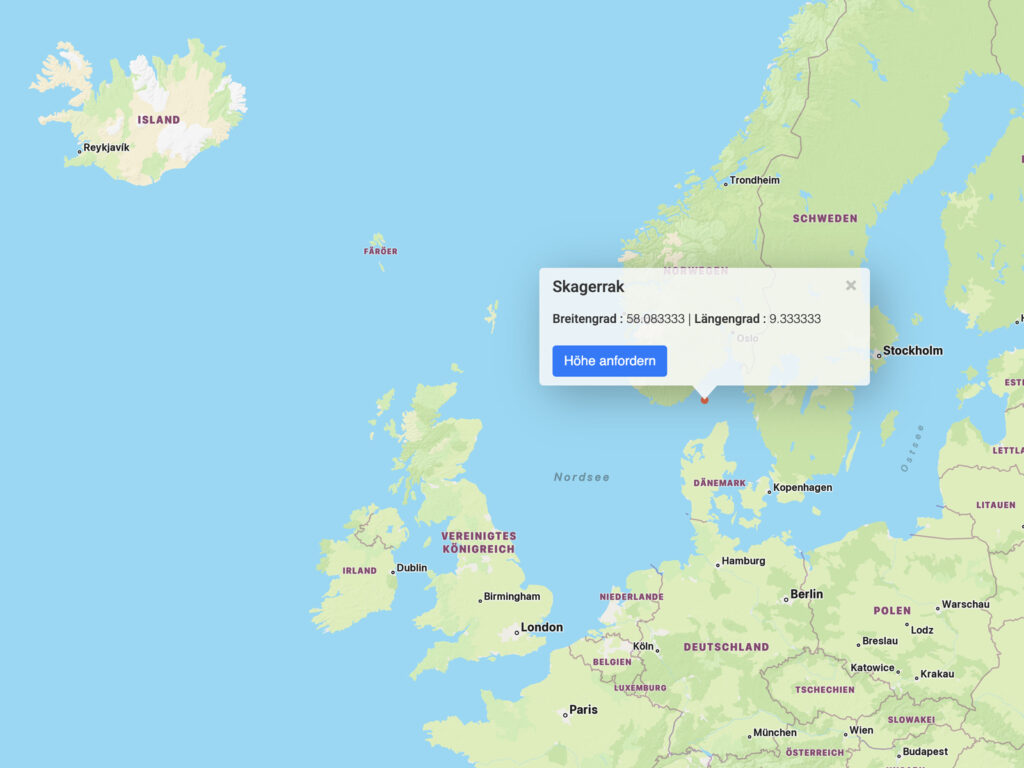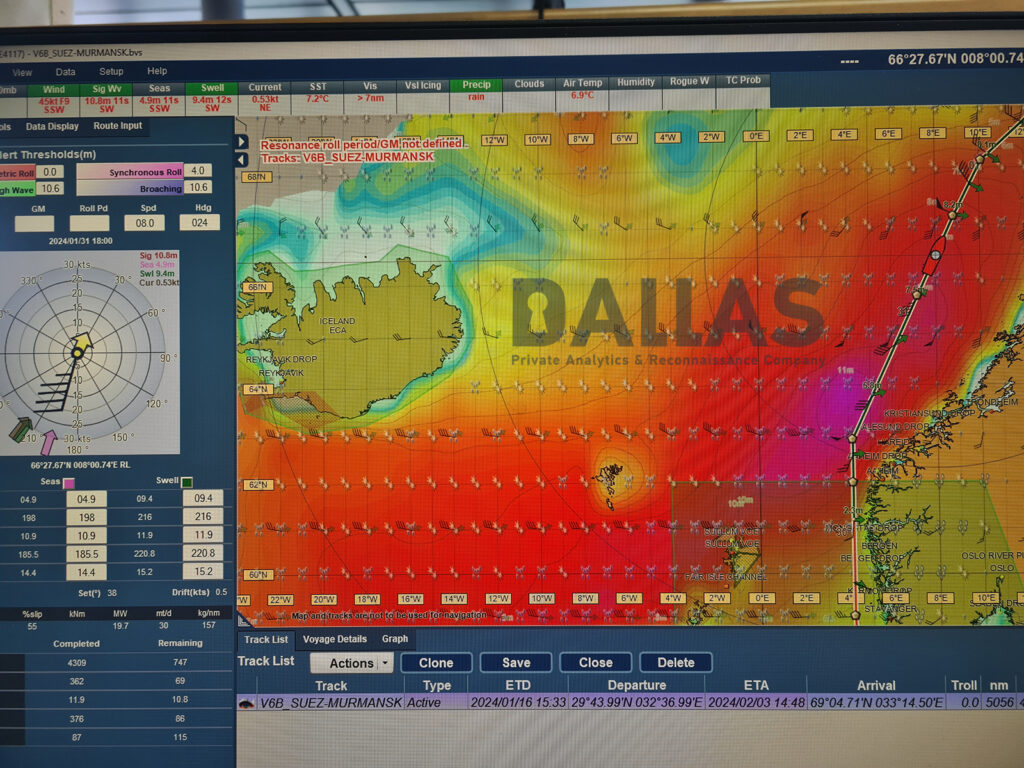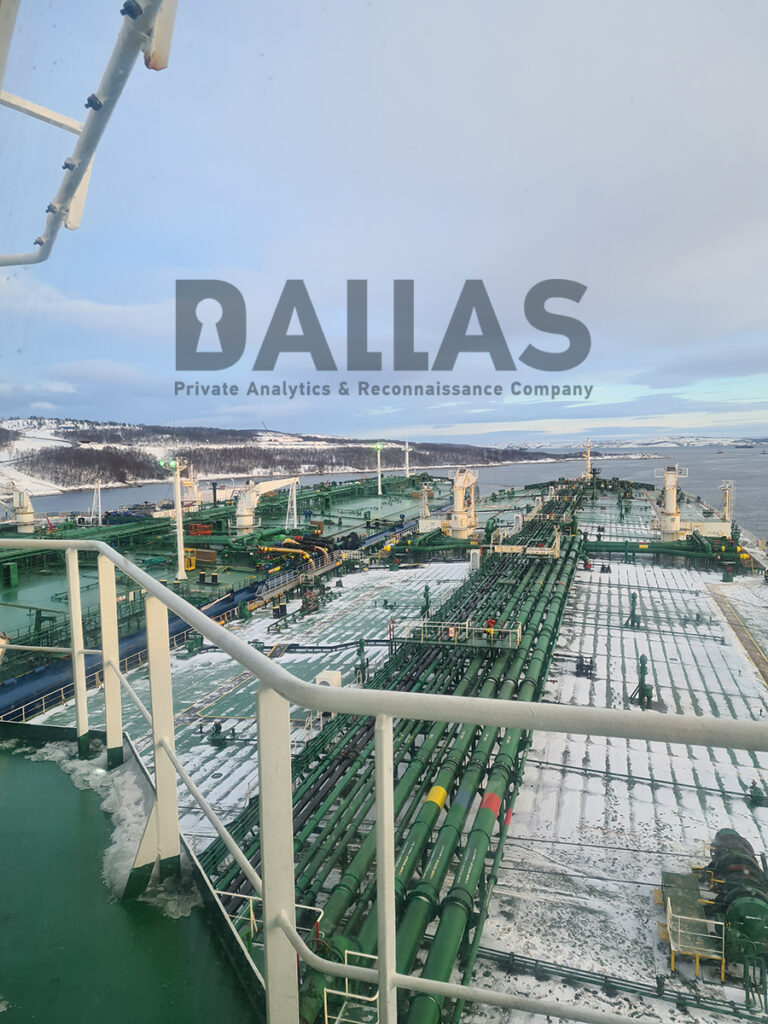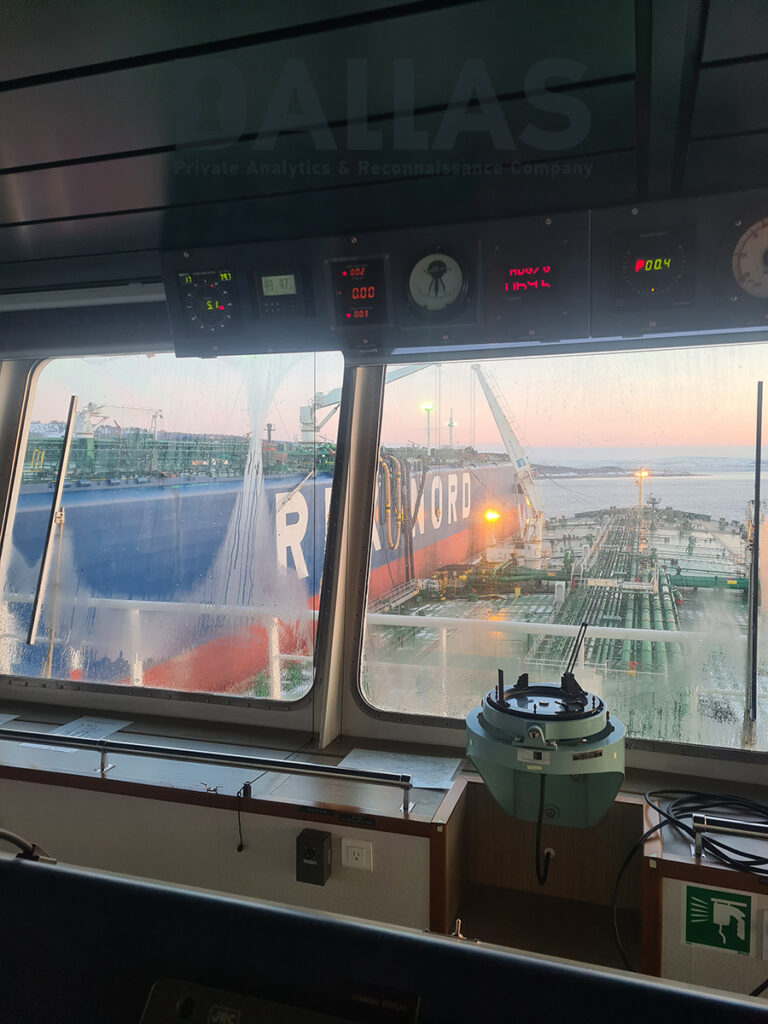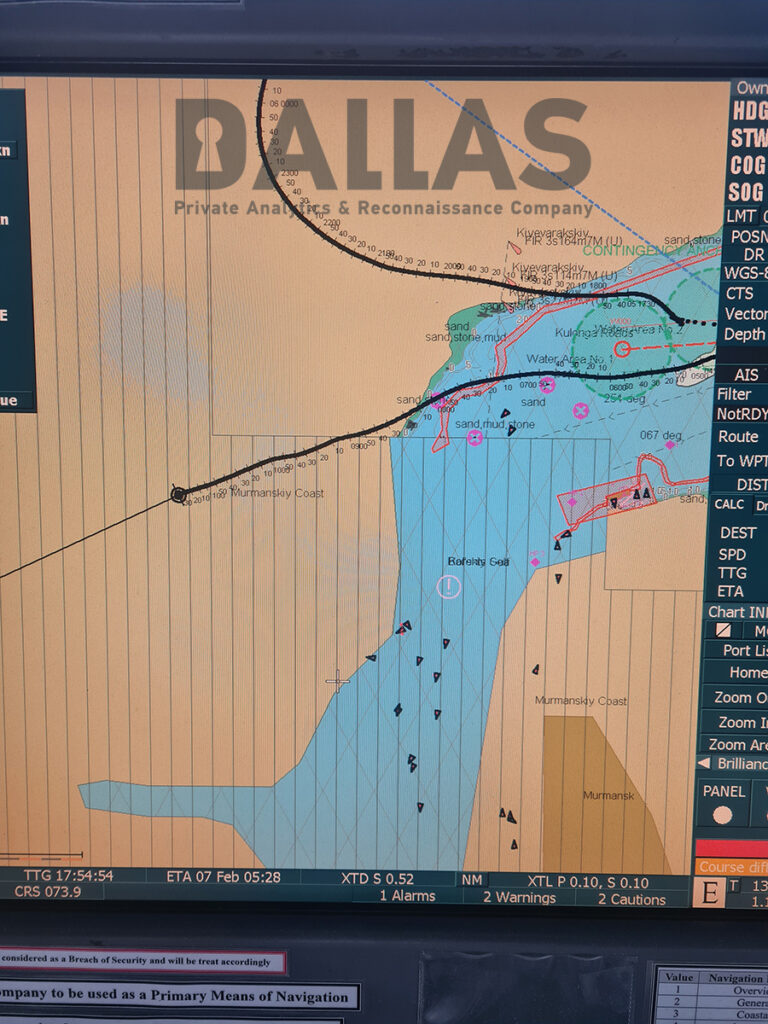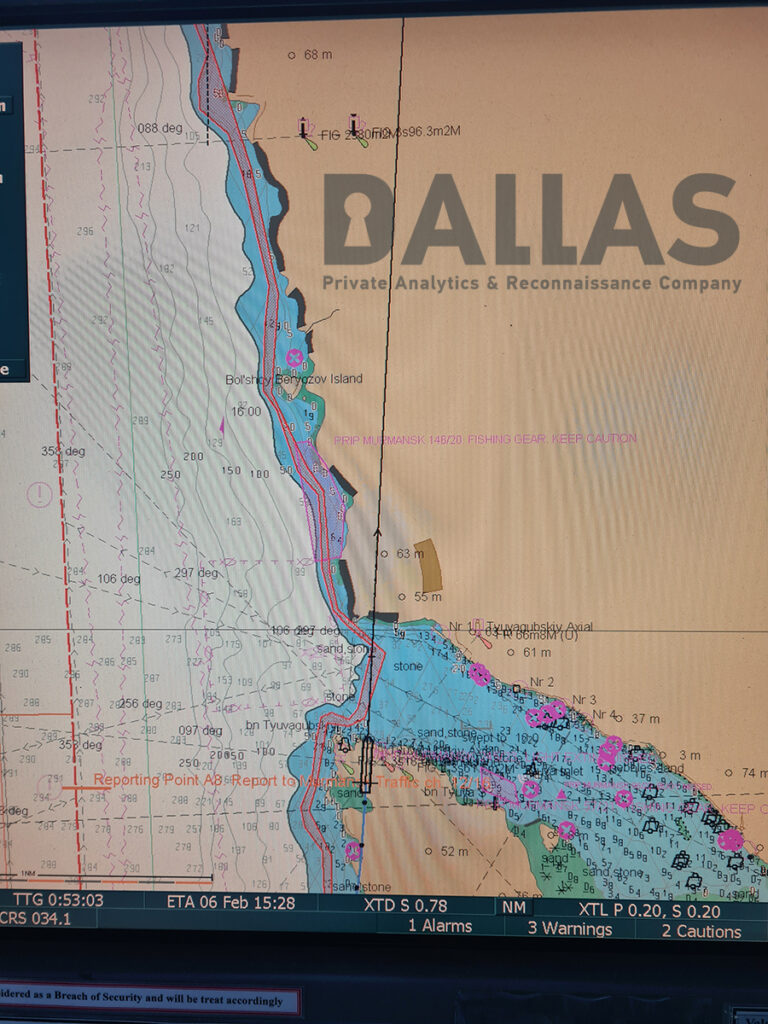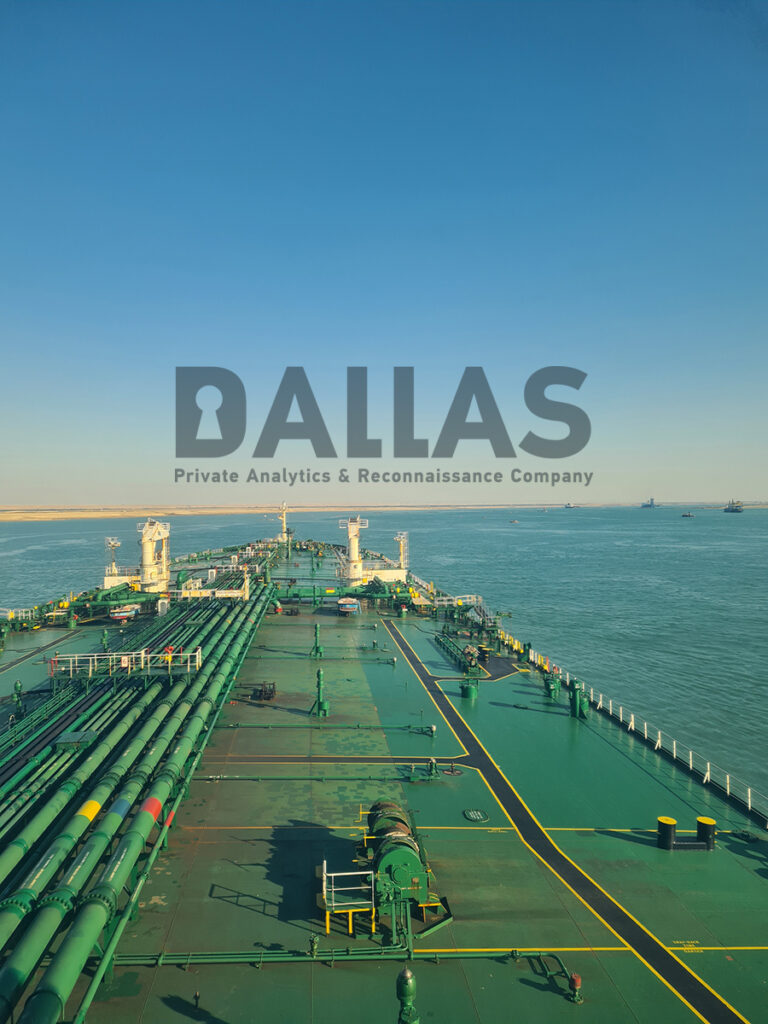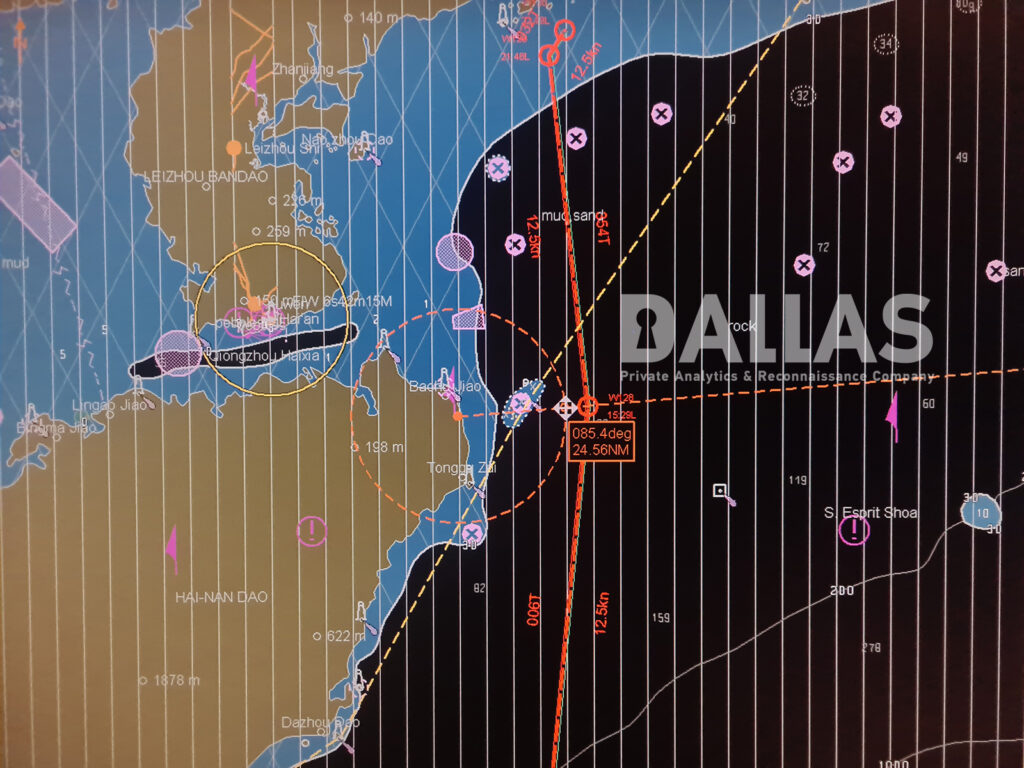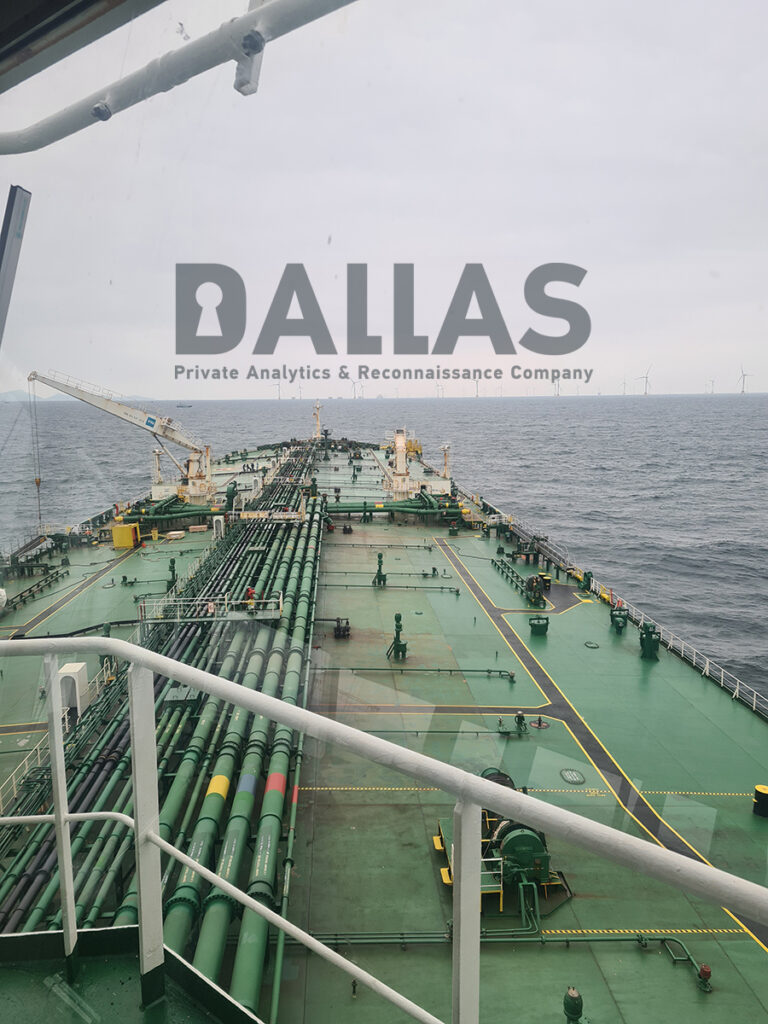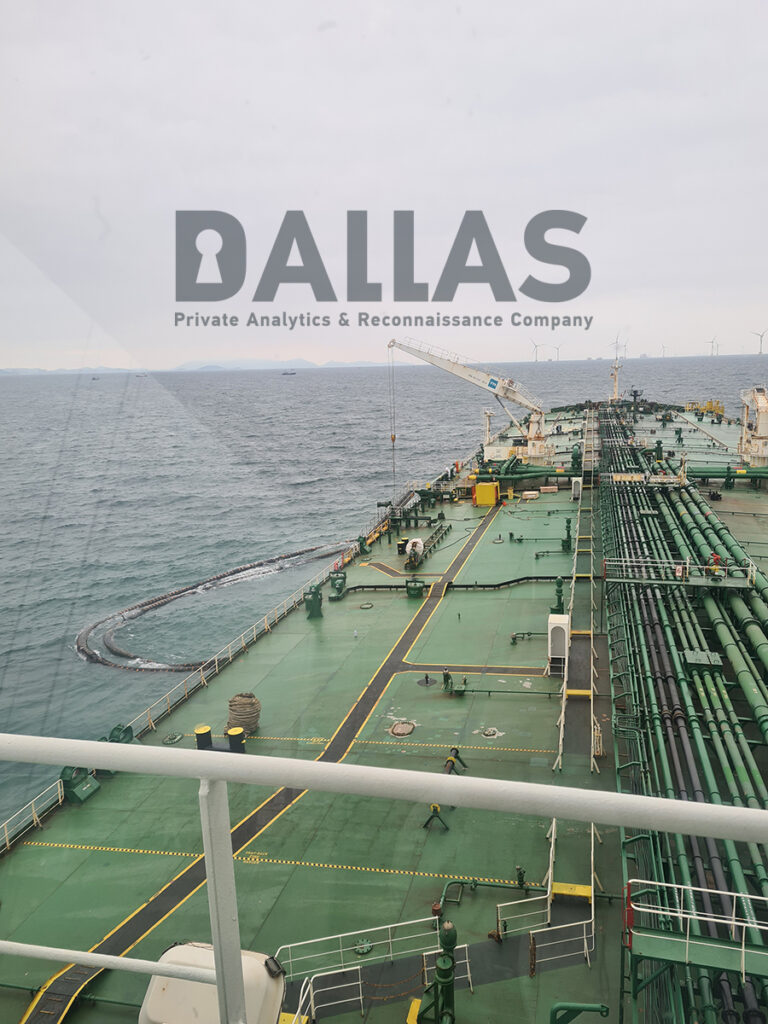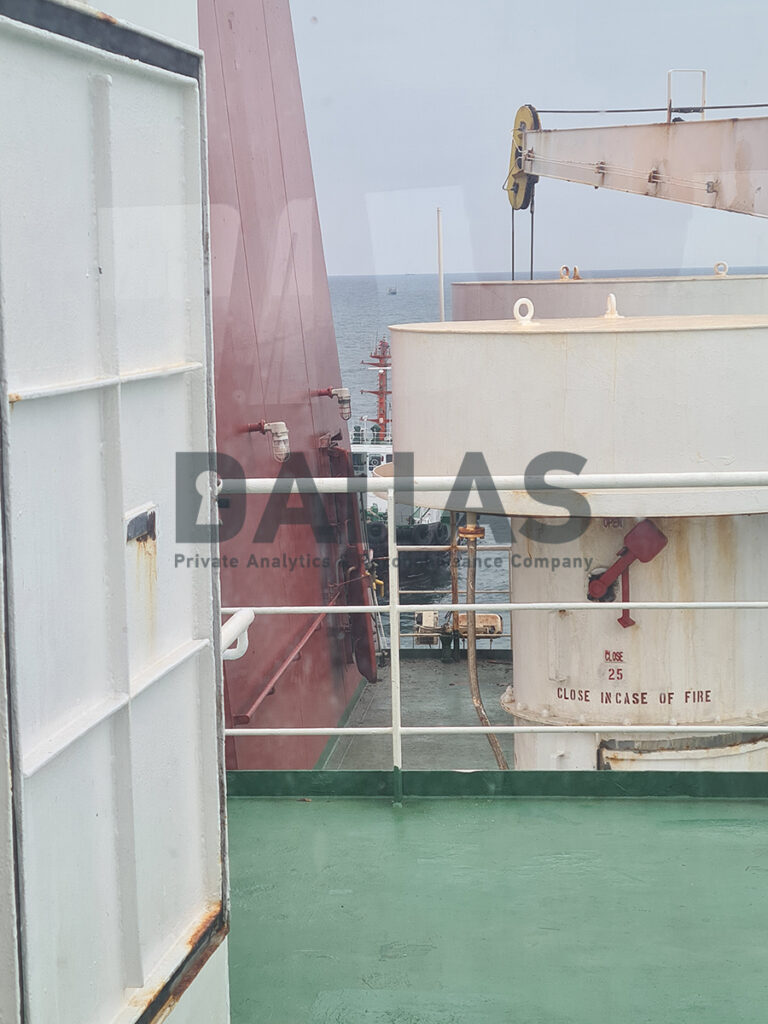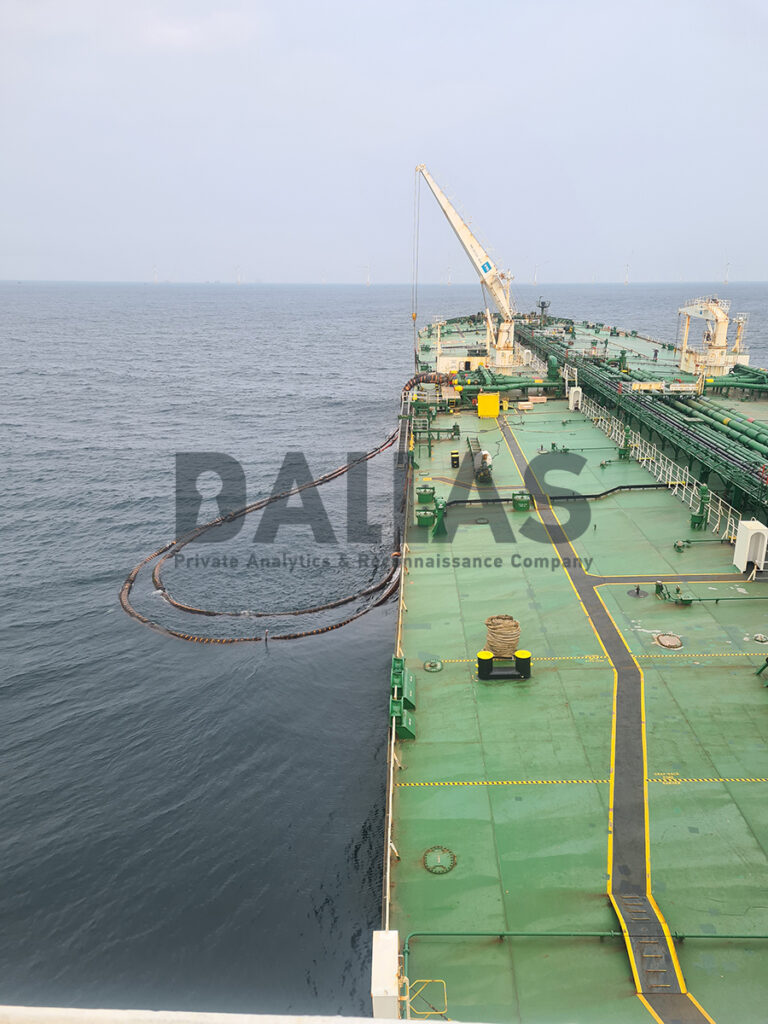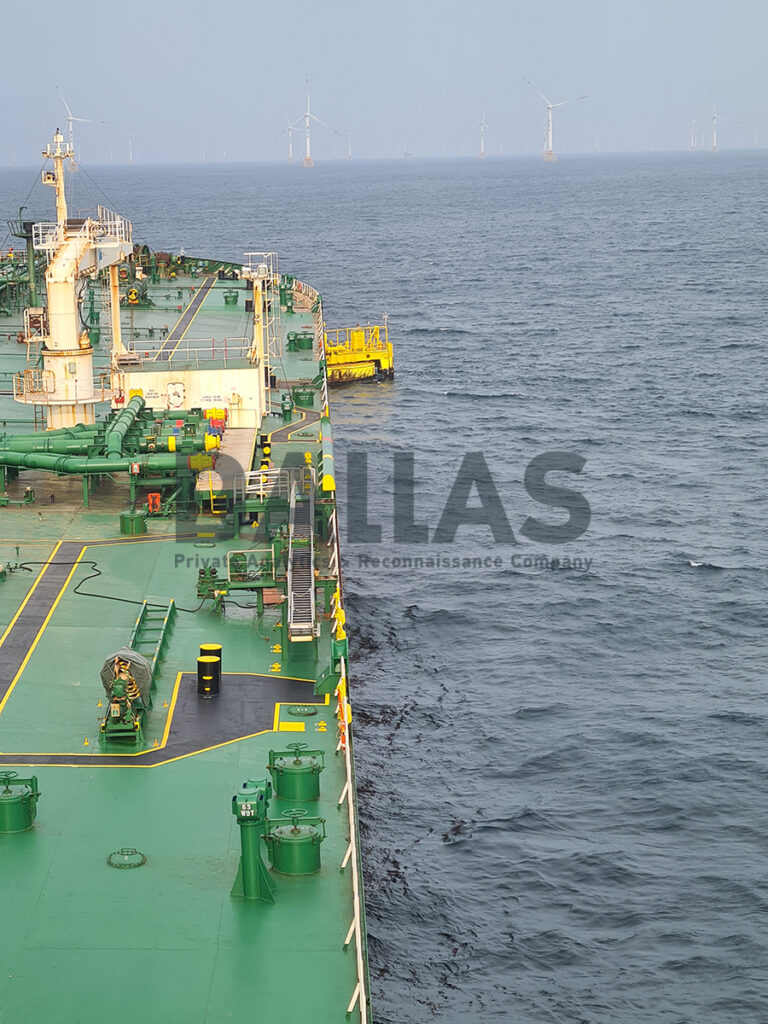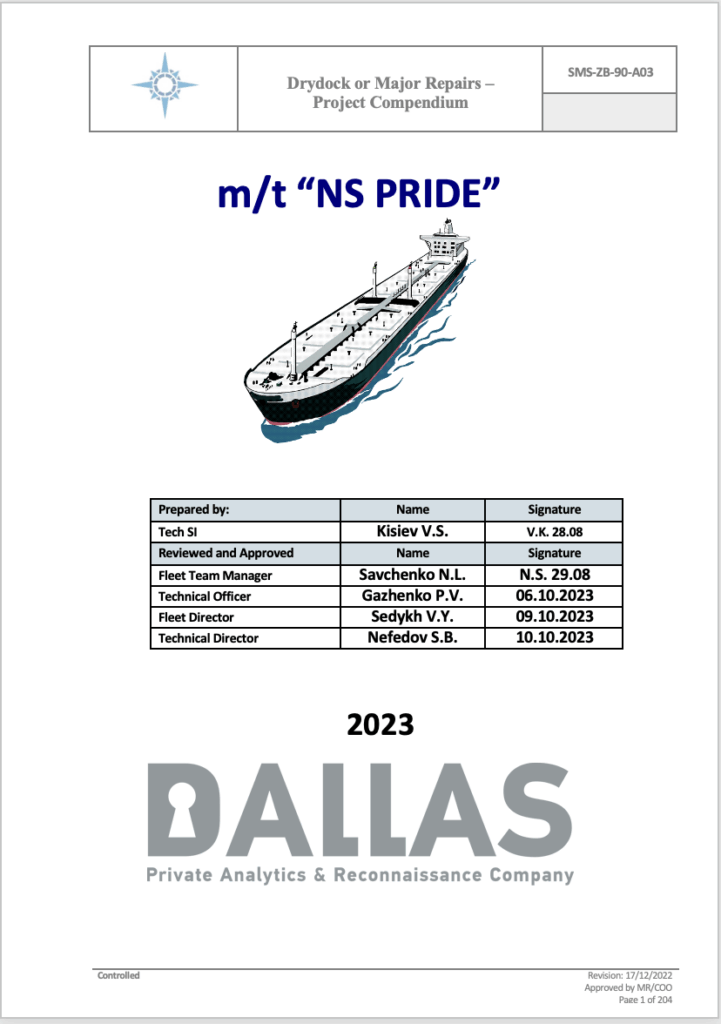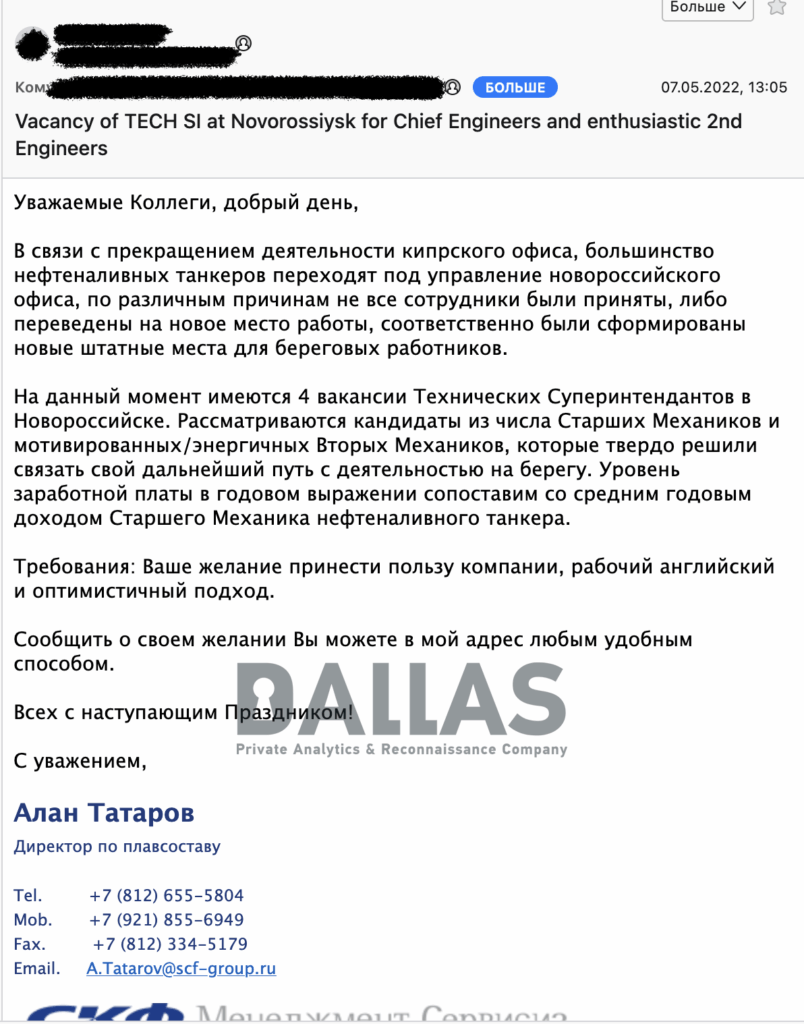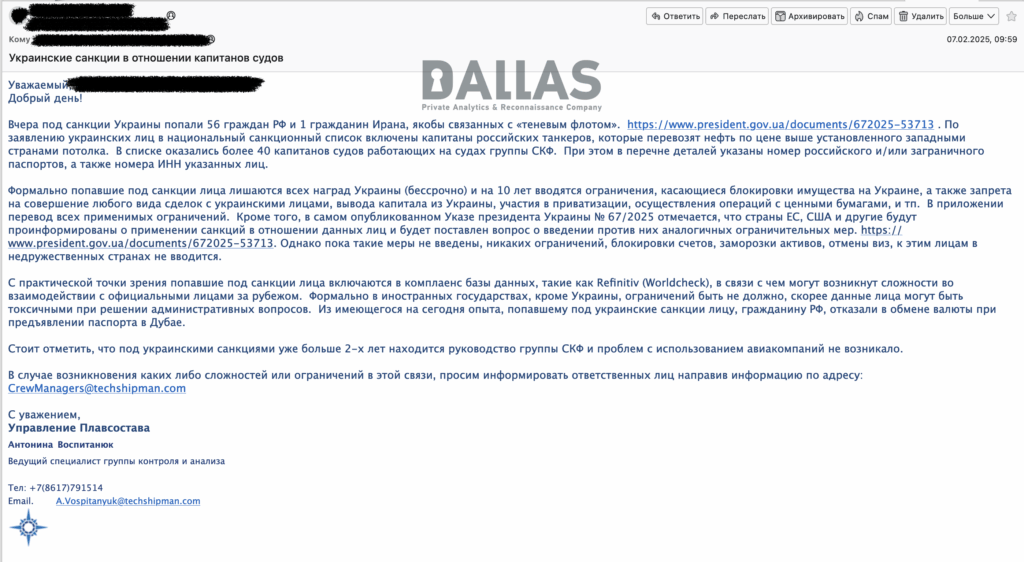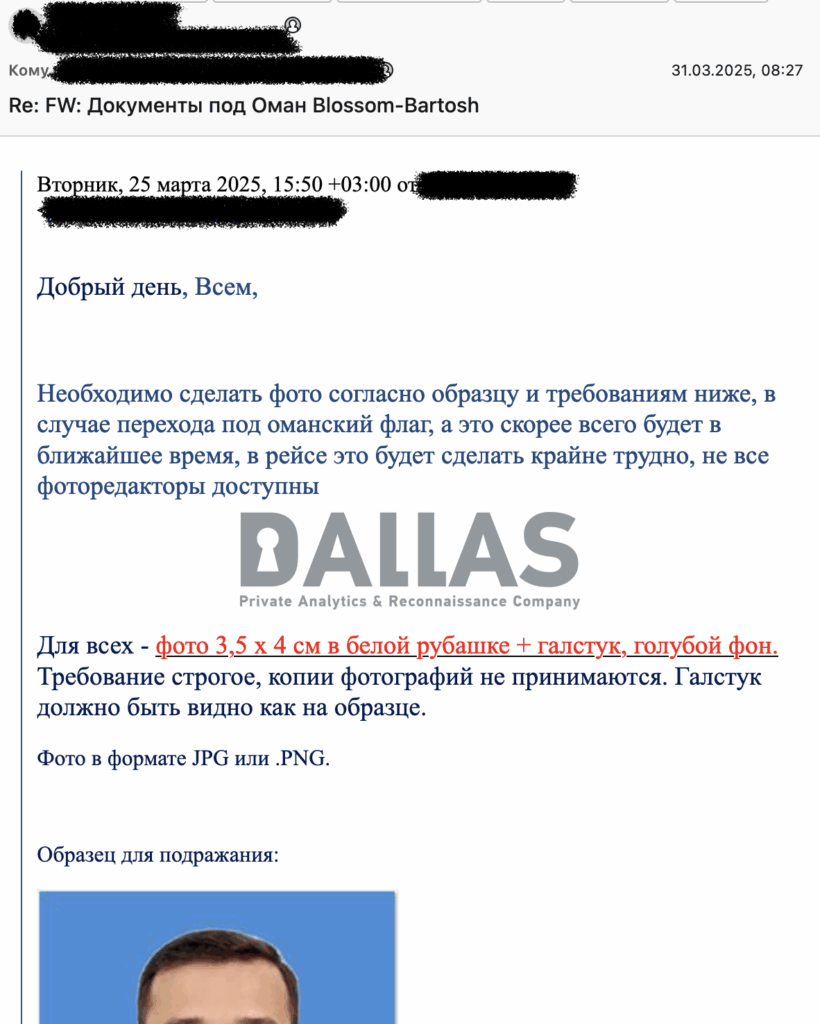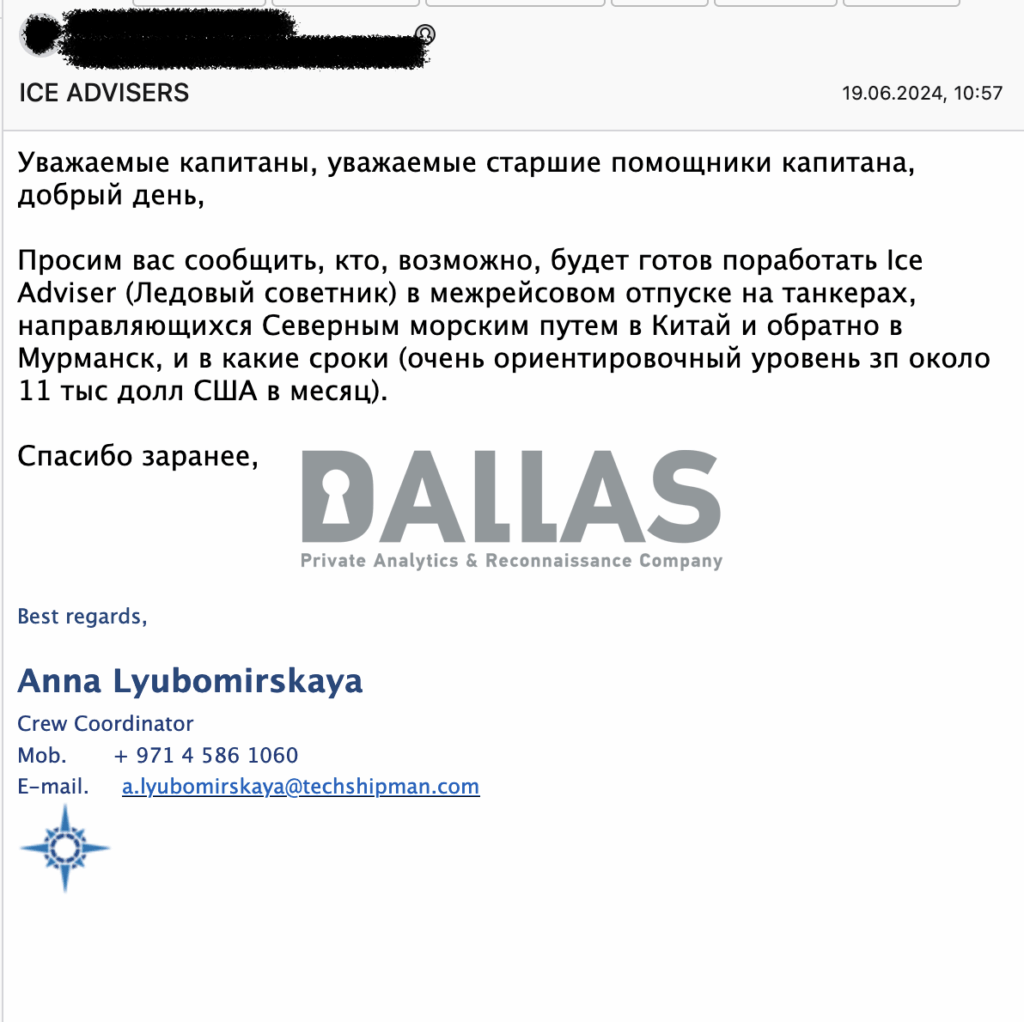The private analytics and intelligence company Dallas obtained dozens databases from captains of Russia’s tanker fleet – linked to major sanctioned companies like Sovcomflot, Rosnefteflot, and RPK Nord. Drawing from this trove of data, this investigation follows one tanker’s journey from the Barents Sea to China’s southern coast. The story will show how the shadow fleet moves Russian oil in defiance of sanctions, how it may support intelligence-gathering missions, and what steps can be taken to shut it down. The Myrotvorets Center provided Dallas with a dataset identifying more than 60 captains linked to the fleet – making this in-depth look possible.
Russia’s War Economy at Sea
Now in its fourth year, Russia’s full-scale aggression against Ukraine has become a grinding war of attrition. Russia can only sustain this war with steady cash flowing into its economy. Energy exports remain the Kremlin’s financial lifeline.
After the G7 imposed oil trade restrictions, Moscow responded by building a parallel global logistics system – an unofficial tanker network designed to skirt sanctions. The world now knows this network as the shadow fleet.
These vessels routinely turn off transponders, falsify location data, operate under flags of convenience, and transfer oil between ships at night, in secret. Most operate through shell companies and hide their ownership structure. According to Ukrainian defence intelligence, the fleet also uses dangerous transport methods that increase environmental risk and defy international law. This is what that system looks like in action.
Tracking the Captain of the SABLE
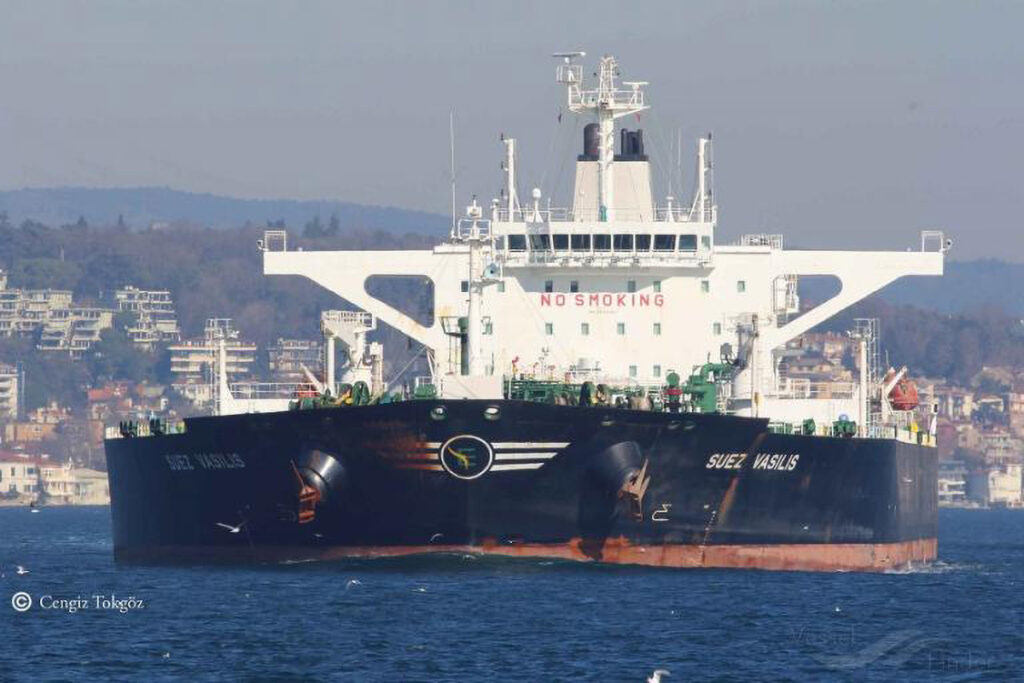
One vessel, built in 2011 and originally flagged in the Marshall Islands as SUEZ VASILIS, reflagged to Liberia in 2021 under the name NAUTILUS I. Then in November 2022, after Russia had launched its full-scale invasion, the vessel changed owners, managers, flag, and name again – becoming SABLE under Panama flag.
Dallas obtained a personal photo and passport scan of Mikhail Gushchin, the ship’s master. His emails revealed key contract and navigation data. On November 5, 2023, Gushchin signed on as master in the port of Primorsk, Russia. The manager was Prominent Shipmanagement Limited.
Contract for performing the functions of a master
Ship logs show that in the second half of 2023, SABLE completed two full voyages from Murmansk to Myanmar. In October, it anchored off Malta. A few weeks later, Gushchin boarded the ship in Primorsk.
We know SABLE made at least two trips to China while Gushchin commanded it. While the first voyage’s cargo details remain unclear, Gushchin took a screenshot on November 20, 2023, showing the ship en route from Primorsk to Zhoushan, China. It was scheduled to arrive around December 20.
On December 19, he received new routing instructions via email. Gazpromneft – the Russian oil giant – told him to sail to the Suez Canal after delivery and await further orders.
According to logs, the ship left Murmansk around February 8–9, 2024, with a cargo of 140,000 tonnes of Novy Port crude – a type of Arctic oil extracted through high-cost, specialized infrastructure.
Preliminary voyage instructions received by Gushchin
Although SABLE sailed under a Panamanian flag, both the cargo and crew were Russian – with the exception of one Belarusian sailor. Gushchin even snapped a photo of the Panamanian flag fluttering above the stern as SABLE sailed back from China.
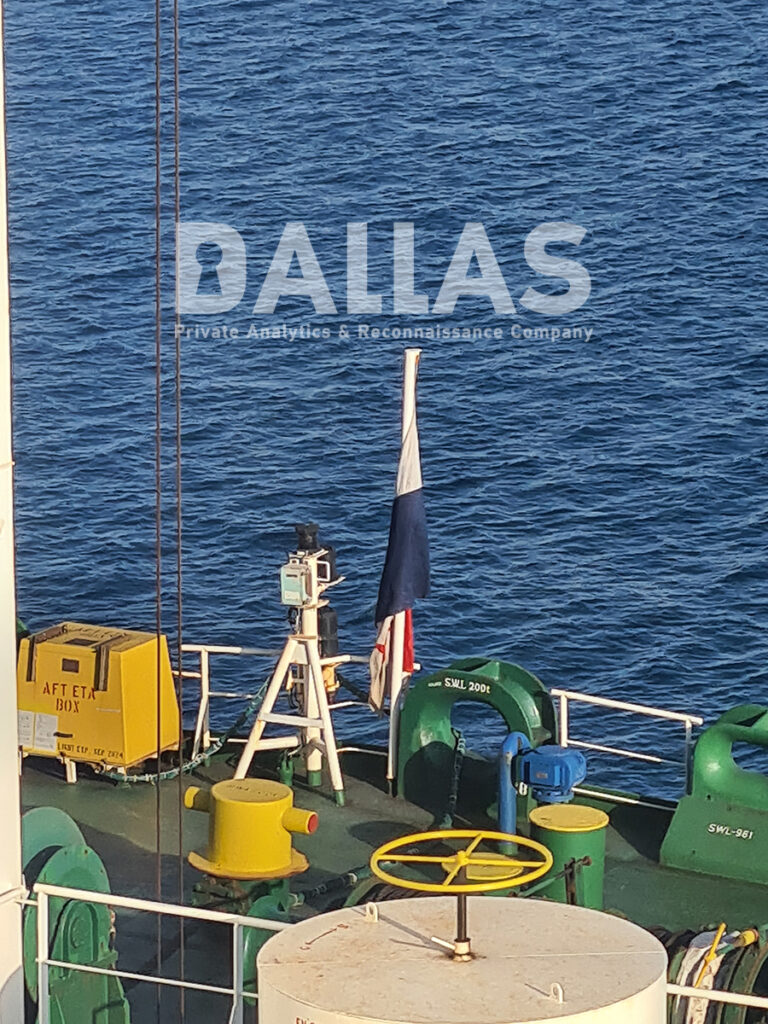
A photo of the Panamanian flag taken by Gushchin on his way back from China
Surveillance or Sanctions Run?
The ship moved ahead of schedule so the estimated time of arrival at the Russian port of destination was February 03 or 04. But between January 24 and 30, SABLE lingered strangely in place for nearly six days – with conflicting location data.
On January 24, the master took a screenshot of the vessel’s position near the Norwegian coast at coordinates 58°05.00’ N, 009°20.00’ E. On January 30, he took another screenshot, showing the vessel at 66°27.67’ N, 008°00.74’ E — not much farther. Visually, it appeared that the ship had moved very little.
If we check the first coordinates (58°05.00’ N, 009°20.00’ E), we will find that this point lies in the Skagerrak Strait between Jutland and the Scandinavian Peninsula – an entirely different location that shouldn’t intersect with the ship’s route at all. Moreover, this point totally differs from the actual vessel’s position in the navigation screen 24.01.2024.
This raises two key questions:
- Why does the ship’s navigation system screenshot from January 24 show one location, while the coordinates point to another?
- What was the ship doing for six days in nearly the same area off Norway’s western coast?
Unfortunately, Gushchin’s email offers no answers. However, according to Ukraine’s defence intelligence (HUR), Russia uses the shadow fleet as a tool in its hybrid warfare strategy. In particular, Russian tankers frequently spoof navigation data, which likely explains the major discrepancy between the reported and actual coordinates.
HUR noted that “there have been confirmed cases of shadow fleet vessels participating in reconnaissance and sabotage operations – particularly in the Baltic Sea, where they monitor naval infrastructure, undersea cables, and other critical assets.” This may help explain why a Russian tanker lingered off the coast of a NATO country for 6 days – one of the few reasonable conclusions we can draw based on the available data.
Gushchin’s emails contain no reports of technical malfunctions, emergencies, or any irregular events aboard the vessel during those days. There’s also no indication that the ship had to wait out bad weather for six days or adjust its schedule due to early arrival. Clearly, if a storm had forced the vessel to halt, it would not have spoofed its navigation data or broadcast false coordinates.
All of this only strengthens suspicions that the shadow fleet plays a role in covert surveillance of Russia’s perceived enemies.
Arctic Oil, Asian Buyers
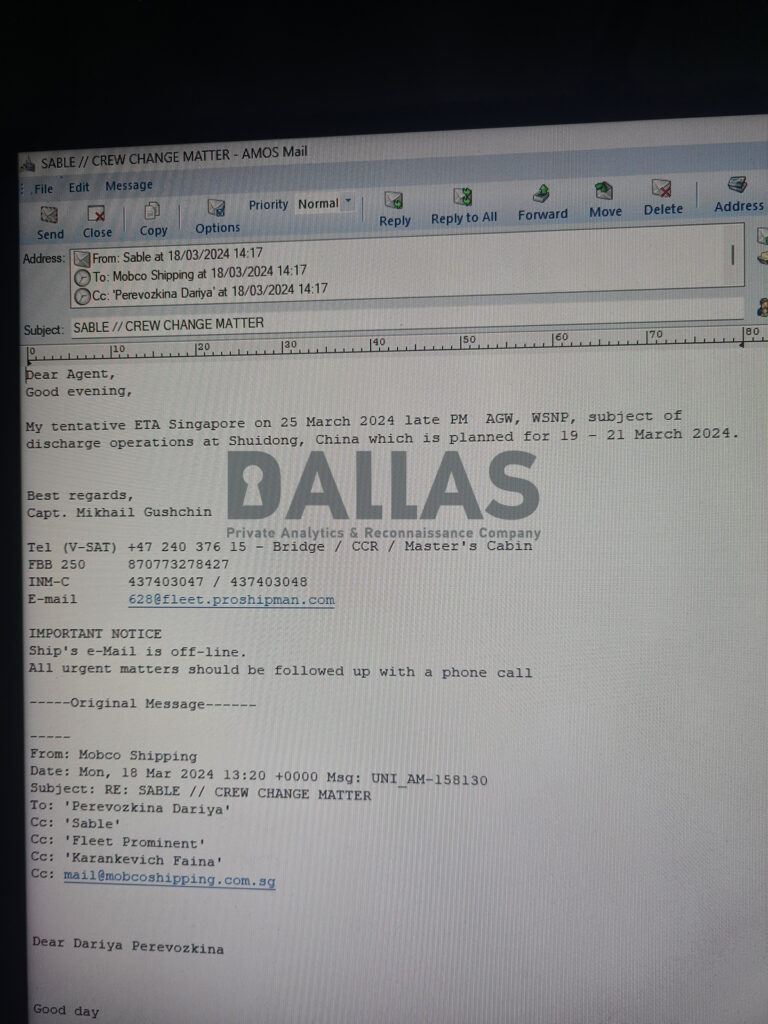
On February 2, Gushchin received additional orders for his voyage. He would load 140,000 tonnes of another type of Arctic crude – this time, ARCO-grade – in Kola Bay, near Murmansk.
He photographed the loading process between February 4–5. Notably, this occurred through ship-to-ship oil transfers, a practice that can pose additional environmental risks.
The tanker then continued its route through the Suez Canal toward China. On February 13, however, Gushchin sent a report to his employers at Gazpromneft. This report reveals the final destination of the voyage: the Chinese port of Shuidong, where the tanker was scheduled to arrive on March 18, 2024.
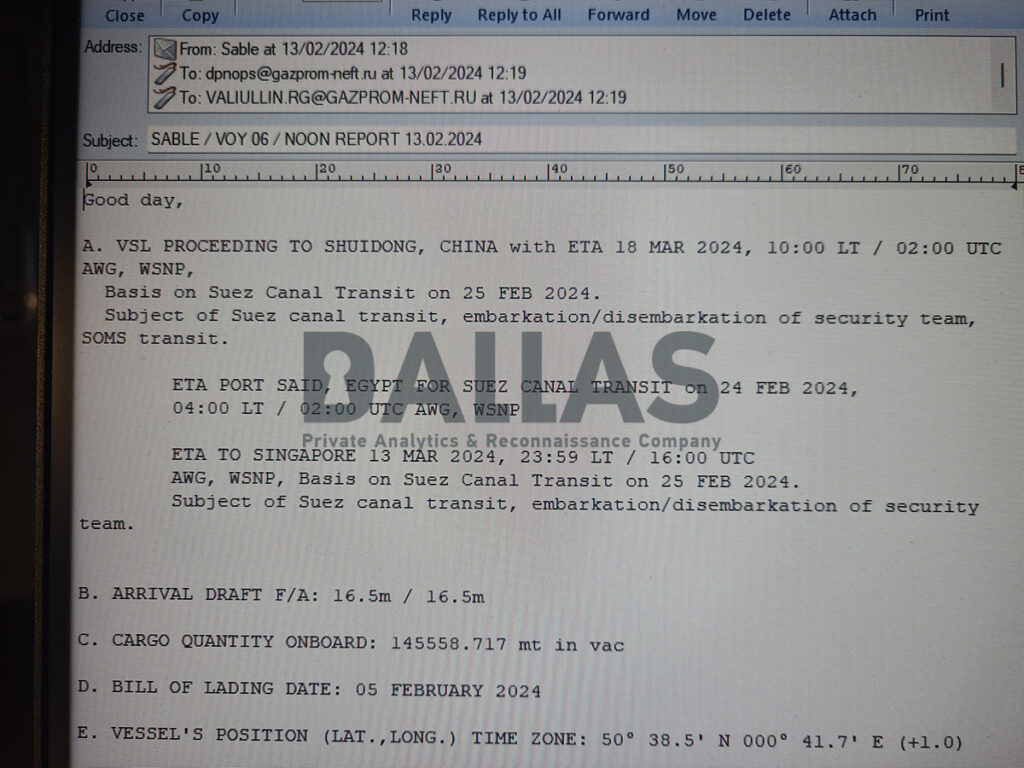
Shuidong is a port located in southern China. Its official port code is CNSDG. It is also known by several other names, including SHUI DONG, MAO MING, MAOMING, and MAO MIN.
SABLE arrived in China with almost no delays. The unloading of Russian oil was scheduled for March 19–21, 2024. Below is an Excel form filled out by Gushchin for the Chinese port, detailing the order of vessels for cargo unloading. SABLE is listed as number 1.
These data on the unloading dates in Shuidong were confirmed by Gushchin’s letter to Singapore, where the ship was to go after unloading:
Here are some photos taken by Gushchin on March 19–20, 2024, near the Chinese coast, marking the final stage of the voyage from Murmansk to China:
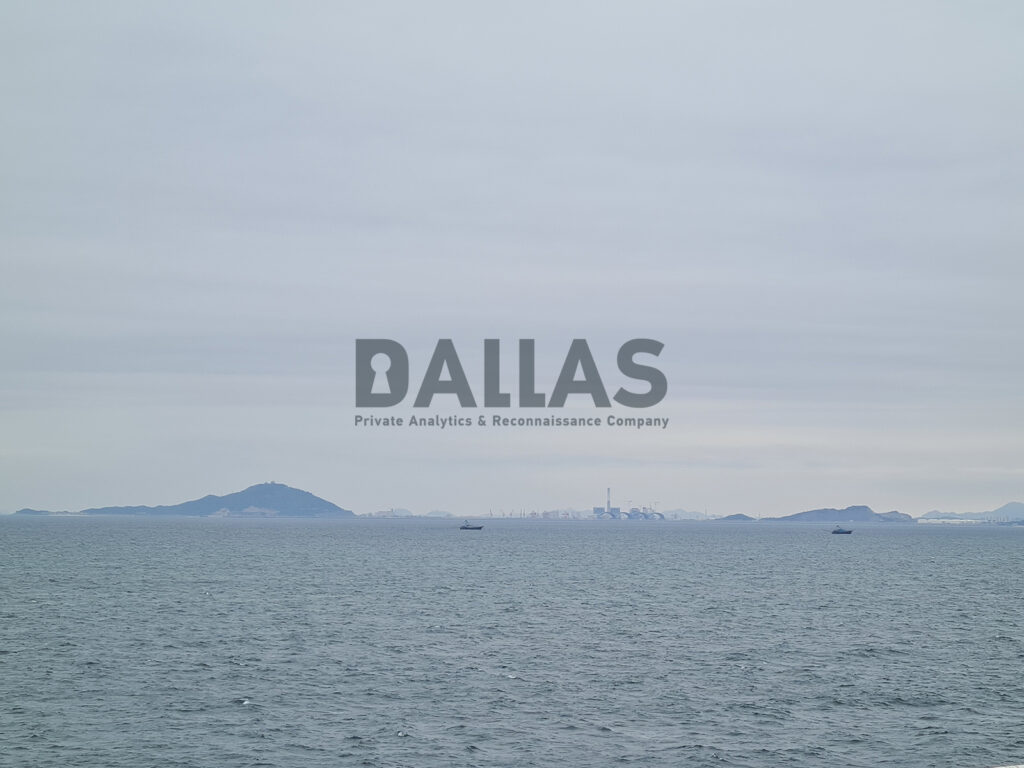
Sanctions Evasion, Step by Step
On January 10, 2025, the United States issued new sanctions targeting Russia’s shadow fleet. SABLE and its manager Prominent Shipmanagement Limited appeared on the list.
Russia responded with a familiar playbook:
- February 1: The ship reflagged to Barbados and changed name to SABINA.
- February 20: A new company, GLORY SHIPPING HK LTD, took over management.
- May 1: The vessel reflagged again – this time to the Comoros.As of July 2025, SABINA has just completed another voyage to China and is returning westward through the Suez Canal.
As of July 2025, SABINA has just completed another voyage to China and is returning westward through the Suez Canal.
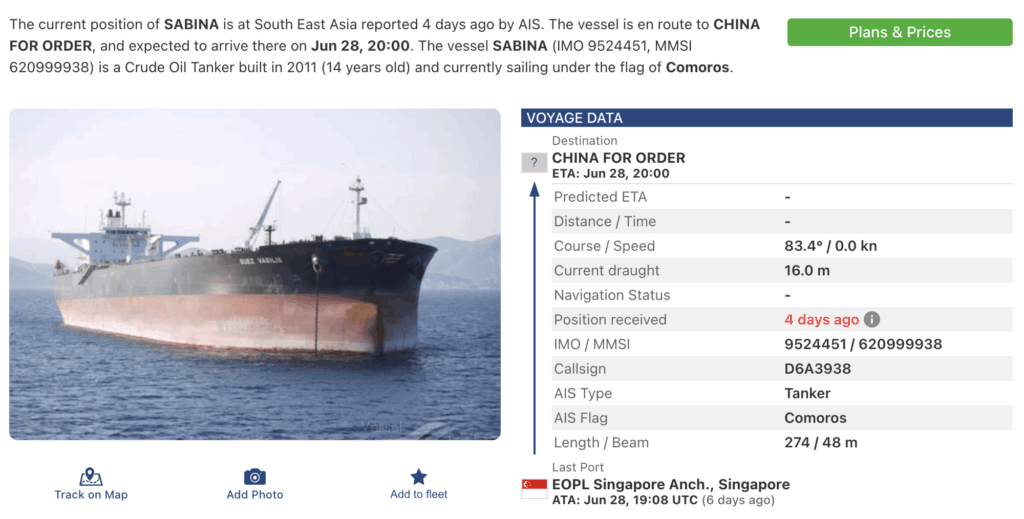
Why the Sanctions Fall Short
Sanctions have made life harder for Russian shipping firms. Every new name, flag, or company change proves that. But sanctions alone haven’t stopped these vessels from moving oil.
Only the U.S. has sanctioned SABLE/SABINA. Neither the EU nor the UK have included this particular ship in their lists, and this needs to be corrected urgently.
To tighten the net, governments must:
- Ban all shadow fleet vessels from entering ports.
- Scrutinize documents, insurance policies, and ship logs.
- Freeze bank accounts and financial pathways supporting the trade.
- Track ship-to-ship transfers and offshore transfers outside territorial waters.
Сertain positive dynamics is observed. For example, Australia imposed its first sanctions on Russia’s shadow fleet on June 18, 2025. The United Arab Emirates banned tankers using landlocked Eswatini’s flag. Germany now requires full insurance transparency for tankers entering its waters since April 1, 2025 – e.g. coverage for damage caused by oil pollution.
At the same time, these actions remain only a temporary fix. For example, in January this year, Shandong Port Group, one of China’s largest port companies, banned servicing tankers under U.S. sanctions. But as we saw from Master Gushchin’s archive, it’s quite possible his ship never entered the port. So, China can “close its ports” all it wants, but it will continue accepting Russian oil at sea. The fact that the sanctioned vessel SABLE/SABINA is still delivering oil right now shows China has no intention of stopping this flow.
In April 2025, Estonia detained a tanker in its waters believed to belong to the shadow fleet. Authorities found multiple violations on board and banned the ship from continuing until the issues were fixed, but eventually released it.
It’s no surprise that Russia has started pushing back. In May, the Estonian Navy tried to intercept an oil tanker heading to Russia that is under UK sanctions. The operation involved a helicopter, a plane, and the patrol vessel EML Raju. In response, Russia scrambled a Su-35S fighter jet to protect the tanker. Despite demands to change course, the tanker’s crew refused to comply. The vessel anchored near Gogland Island in the eastern Baltic Sea.
Recent reports reveal that Russia has begun escorting its tankers with military vessels, highlighting just how critical oil shipments remain to the Kremlin. Yet the shadow fleet isn’t the root cause – it’s a symptom. The real issue is that stronger sanctions targeting Russia’s oil and energy sectors were not implemented sooner. Ultimately, only a sharp decline in oil prices will truly weaken Moscow’s grip, as well as a secondary sanctions against oil buyers.
Afterword
The private analytical and intelligence company Dallas invites researchers, journalists, and other interested parties to independently explore a unique database containing communications from several captains of the Russian shadow fleet. To gain access, submit a request through the project’s website and be among the first to get an inside look at this covert operation.
These archives will soon be available to our members, offering valuable insights – including detailed documents on dock repairs and the technical condition of key oil tankers.
Either how Russians respond to sanctions by closing their offices abroad and frequently re-registering captains to sail under new flags, or how they receive directives about implementing personal sanctions.
The available data will also reveal how Russians evade sanctions by rerouting shipments through the Northern Sea Route to China.
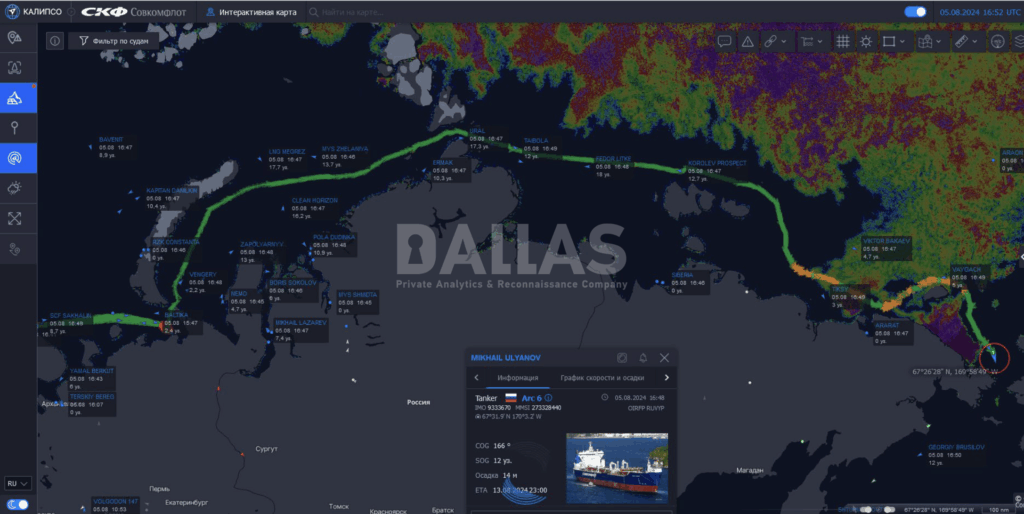
The route of the Mikhail Ulyanov tanker along the Northern Sea Route to China from Sovcomflot’s internal navigation network




